
A mixing console or mixing desk is an electronic device for mixing audio signals, used in sound recording and reproduction and sound reinforcement systems. Inputs to the console include microphones, signals from electric or electronic instruments, or recorded sounds. Mixers may control analog or digital signals. The modified signals are summed to produce the combined output signals, which can then be broadcast, amplified through a sound reinforcement system or recorded.
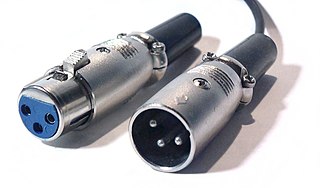
The XLR connector is a type of electrical connector primarily used in professional audio, video, and stage lighting equipment. XLR connectors are cylindrical in design, with three to seven connector pins, and are often employed for analog balanced audio interconnections, AES3 digital audio, portable intercom, DMX512 lighting control, and for low-voltage power supply. XLR connectors are included to the international standard for dimensions, IEC 61076-2-103. The XLR connector is superficially similar to the smaller DIN connector, with which it is physically incompatible.
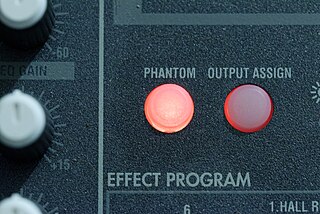
Phantom power, in the context of professional audio equipment, is DC electric power equally applied to both signal wires in balanced microphone cables, forming a phantom circuit, to operate microphones that contain active electronic circuitry. It is best known as a convenient power source for condenser microphones, though many active direct boxes also use it. The technique is also used in other applications where power supply and signal communication take place over the same wires.

A preamplifier, also known as a preamp, is an electronic amplifier that converts a weak electrical signal into an output signal strong enough to be noise-tolerant and strong enough for further processing, or for sending to a power amplifier and a loudspeaker. Without this, the final signal would be noisy or distorted. They are typically used to amplify signals from analog sensors such as microphones and pickups. Because of this, the preamplifier is often placed close to the sensor to reduce the effects of noise and interference.
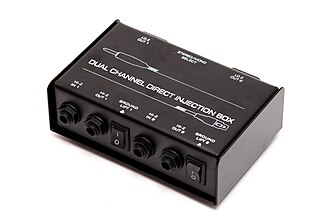
A DI unit is an electronic device typically used in recording studios and in sound reinforcement systems to connect a high output impedance unbalanced output signal to a low-impedance, microphone level, balanced input, usually via an XLR connector and XLR cable. DIs are frequently used to connect an electric guitar or electric bass to a mixing console's microphone input jack. The DI performs level matching, balancing, and either active buffering or passive impedance matching/impedance bridging. DI units are typically metal boxes with input and output jacks and, for more expensive units, “ground lift” and attenuator switches.

An audio multicore cable is a thick cable which usually contains 4–64 individual audio cables inside a common, sturdy outer jacket. Audio multicore cables are used to convey many audio signals between two locations, such as in audio recording, sound reinforcement, PA systems and broadcasting. Multicores often route many signals from microphones or musical instruments to a mixing console, and can also carry signals from a mixing console back to speakers.
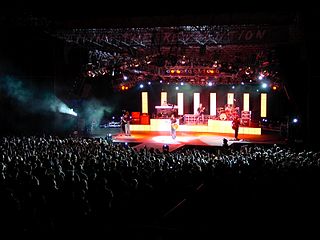
A sound reinforcement system is the combination of microphones, signal processors, amplifiers, and loudspeakers in enclosures all controlled by a mixing console that makes live or pre-recorded sounds louder and may also distribute those sounds to a larger or more distant audience. In many situations, a sound reinforcement system is also used to enhance or alter the sound of the sources on the stage, typically by using electronic effects, such as reverb, as opposed to simply amplifying the sources unaltered.
Midas is a company that designs professional audio consoles. Founded in London in 1970 by Jeff Byers and Charles Brooke, today the company is part of the Music Tribe group of brands.
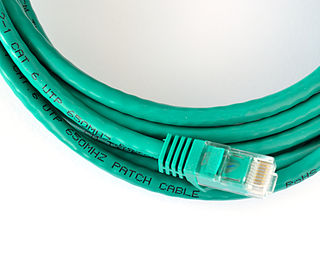
A patch cable, patch cord or patch lead is an electrical or optical cable used to connect one electronic or optical device to another for signal routing. Devices of different types are connected with patch cords.
In audio and broadcast engineering, Audio over Ethernet is the use of an Ethernet-based network to distribute real-time digital audio. AoE replaces bulky snake cables or audio-specific installed low-voltage wiring with standard network structured cabling in a facility. AoE provides a reliable backbone for any audio application, such as for large-scale sound reinforcement in stadiums, airports and convention centers, multiple studios or stages.
A channel strip is a device that allows the output of an audio device to be amplified to a line level and integrated into some other system. An audio channel strip may be a stand-alone unit or one of many units built into a mixing desk. It usually includes a microphone preamp with a switchable phantom power voltage to power condenser microphones and some form of audio equalization. Some designs also offer other facilities including audio compression, de-essing, noise-gating and limiting.

In professional audio, a digital mixing console (DMC) is a type of mixing console used to combine, route, and change the dynamics, equalization and other properties of multiple audio input signals, using digital signal processing rather than analog circuitry. The digital audio samples, which is the internal representation of the analog inputs, are summed to what is known as a master channel to produce a combined output. A professional digital mixing console is a dedicated desk or control surface produced exclusively for the task and is typically more robust in terms of user control, processing power and quality of audio effects. However, a computer can also perform the same function since it can mimic its interface, input and output.
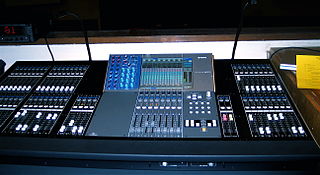
The Yamaha M7CL is a digital mixer that was manufactured by Yamaha Pro Audio. Two models with onboard analog input exist: the M7CL-32 and M7CL-48. These models have 40 - and 56 -input channels respectively, counting mono channels. Mixes, masters, groups, DCAs and individual channels can then be routed to an output via any number of the board's 16 configurable output XLR ports. The eight faders of the master control section can control multiple functions by way of "layers" in the same manner as the Yamaha PM5D. The board features Yamaha's "Selected Channel" technology, and Centralogic, unique to the M7CL. It can be augmented with more inputs or outputs via expansion cards, and can be fitted with third-party cards such as ones made by Aviom (A-Net), AuviTran (EtherSound), Audinate, AudioService (MADI), Dan Dugan (automixer), Riedel Communications (RockNet), Waves Audio, and Optocore. The M7CL-48ES recently joined the line-up with built-in EtherSound for digital networking using EtherSound stage boxes.

Live sound mixing is the blending of multiple sound sources by an audio engineer using a mixing console or software. Sounds that are mixed include those from instruments and voices which are picked up by microphones and pre-recorded material, such as songs on CD or a digital audio player. Individual sources are typically equalised to adjust the bass and treble response and routed to effect processors to ultimately be amplified and reproduced via a loudspeaker system. The live sound engineer listens and balances the various audio sources in a way that best suits the needs of the event.
VENUE is a brand of live sound digital mixing consoles introduced by Digidesign in February 2005. The family now includes 5 different consoles and a number of ways they can be configured. They can all be connected to Pro Tools, the audio editing software also created by Avid/Digidesign, to provide recording and 'Virtual Soundcheck' facilities. One of the system's key marketing points is its use of the same AAX DSP/TDM plugins as Pro Tools, an industry standard digital audio workstation (DAW). This is designed to enable the sounds recorded by the artist in the studio to be easily recreated on stage, and to allow for greater flexibility in signal processing without heavy and mechanical-shock-sensitive racks of external processors. There is also a PC-based offline editor for creation and editing of show files, although there is no audio processing in the editor.

A multicore cable is a type of electrical cable that combines multiple signals or power feeds into a single jacketed cable. The term is normally only used in relation to a cable that has more cores than commonly encountered. Not all cables with multiple insulated conductors are called multicore cables – the core in multicore refers to the number of usable connections made, not the number of conductors or wires. In most cases, a "usable connection" requires multiple conductors, such as the positive and negative conductors used for DC power.
Aviom is a pro audio equipment manufacturer of personal monitoring systems. Headquartered in West Chester, Pennsylvania, Aviom produces distributed audio networking gear which uses a proprietary digital audio transport system called A-Net, based on the physical layer of Ethernet and carried over Category 5 cables terminated with 8P8C connectors. Aviom's Pro16 Monitor Mixing System was nominated in 2005 for a TEC Award, and in 2008 the Pro64 Series won the best Sound System Technology at Musik Messe in Frankfurt, Germany.
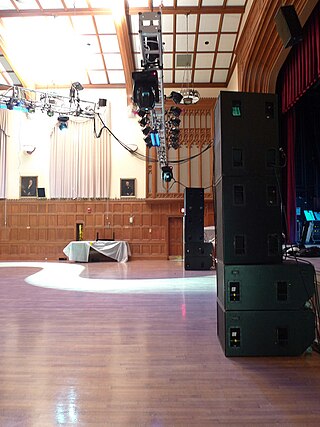
A professional audio store is a retail business that sells, and in many cases rents, sound reinforcement system equipment and PA system components used in music concerts, live shows, dance parties and speaking events. This equipment typically includes microphones, power amplifiers, electronic effects units, speaker enclosures, monitor speakers, subwoofers and audio consoles (mixers). Some professional audio stores also sell sound recording equipment, DJ equipment, lighting equipment used in nightclubs and concerts and video equipment used in events, such as video projectors and screens. Some professional audio stores rent "backline" equipment used in rock and pop shows, such as stage pianos and bass amplifiers. While professional audio stores typically focus on selling new merchandise, some stores also sell used equipment, which is often the equipment that the company has previously rented out for shows and events.

An audio interface is a piece of computer hardware that allows the input and output of audio signals to and from a host computer or recording device.
AES50 is an Audio over Ethernet protocol for multichannel digital audio. It is defined by the AES50-2011 standard for High-resolution multi-channel audio interconnection (HRMAI).

















